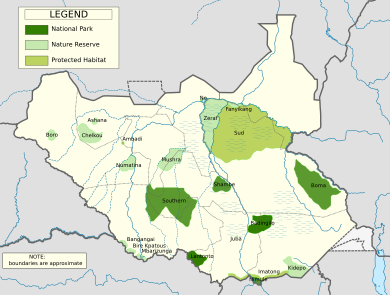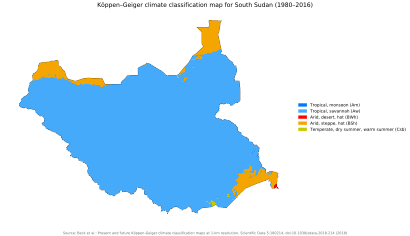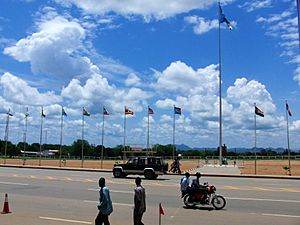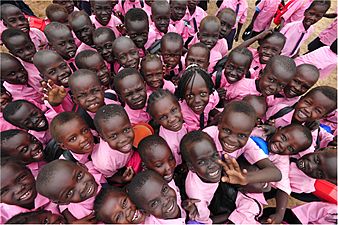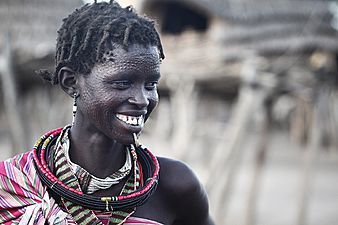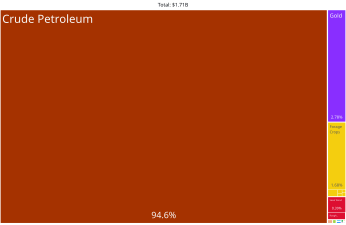South Sudan facts for kids
Quick facts for kids
Republic of South Sudan
|
|
|---|---|
|
|
|
|
Motto:
"Justice, Liberty, Prosperity" |
|

South Sudan in dark green, territory claimed but not fully controlled in light green
|
|
| Capital and largest city
|
Juba 04°51′N 31°36′E / 4.850°N 31.600°E |
| Official languages | English |
| Recognised national languages |
|
| Spoken languages |
|
| Religion
(2023)
|
|
| Demonym(s) | South Sudanese |
| Government | Federal transitional presidential republic |
|
• President
|
Salva Kiir Mayardit |
| Riek Machar | |
|
• Speaker
|
Jemma Nunu Kumba |
| Legislature | Transitional National Legislature |
| Council of States | |
| Transitional National Legislative Assembly | |
| Independence
from Sudan
|
|
|
• Autonomy
|
9 July 2005 |
|
• Declared and recognized
|
9 July 2011 |
| Area | |
|
• Total
|
644,329 km2 (248,777 sq mi) (41st) |
| Population | |
|
• 2023 estimate
|
12,118,379 (80th) |
|
• Density
|
13.33/km2 (34.5/sq mi) (214th) |
| GDP (PPP) | 2022 estimate |
|
• Total
|
|
|
• Per capita
|
|
| GDP (nominal) | 2022 estimate |
|
• Total
|
|
|
• Per capita
|
|
| Gini (2016) | ▼ 44.1 medium |
| HDI (2023) | low · 191st |
| Currency | South Sudanese pound (SSP) |
| Time zone | UTC+2 (Central Africa Time) |
| Date format | dd/mm/yyyy |
| Driving side | right |
| Calling code | +211 |
| ISO 3166 code | SS |
| Internet TLD | .ssa |
|
|
South Sudan, officially the Republic of South Sudan, is a landlocked country in East Africa. It is bordered by Ethiopia, Sudan, the Central African Republic, the Democratic Republic of the Congo, Uganda, and Kenya. Its population was estimated at 11,088,796 in 2023. Juba is the capital and largest city.
South Sudan gained independence from Sudan on 9 July 2011, making it the most recent sovereign state or country with widespread recognition as of 2023. It includes the vast swamp region of the Sudd, formed by the White Nile and known locally as the Bahr al Jabal, meaning "Mountain Sea". Sudan was occupied by Egypt under the Muhammad Ali dynasty and was governed as an Anglo-Egyptian condominium until Sudanese independence in 1956. Following the First Sudanese Civil War, the Southern Sudan Autonomous Region was formed in 1972 and lasted until 1983. A second Sudanese civil war soon broke out in 1983 and ended in 2005 with the Comprehensive Peace Agreement. Later that year, southern autonomy was restored when an Autonomous Government of Southern Sudan was formed. South Sudan became an independent state on 9 July 2011, following 98.8% support for independence in a January 2011 referendum. It has suffered ethnic violence and endured a civil war characterized by rampant human rights abuses from December 2013 until February 2020, when competing combat leaders Salva Kiir Mayardit and Riek Machar struck a unity deal, the R-ARCSS, in 2018 and formed a coalition government, hence paving way for refugees to return home.
South Sudan is one of the least developed countries in the world, ranking last in the Human Development Index, and as of 2022 also one of the poorest countries by GDP per capita. The South Sudanese population is composed mostly of Nilotic peoples, and it is demographically among the youngest nations in the world, with roughly half under 18 years old. The majority of inhabitants adhere to Christianity or various Indigenous faiths. The country is a member of the United Nations, the African Union, the East African Community, and the Intergovernmental Authority on Development.
Contents
Etymology
The name Sudan derives from the Arabic bilād as-sūdān (بلاد السودان), or the "Land of the Blacks".
Geography
South Sudan lies between latitudes 3° and 13°N, and longitudes 24° and 36°E. It is covered in tropical forest, swamps, and grassland. The White Nile passes through the country, passing by Juba.
South Sudan's protected area of Bandingilo National Park hosts the second-largest wildlife migration in the world. Boma National Park, west of the Ethiopian border, as well as the Sudd wetland and Southern National Park near the border with Congo, provide habitat for large populations of hartebeest, kob, topi, buffalo, elephants, giraffes, and lions.
South Sudan's forest reserves also provided habitat for bongo, giant forest hogs, red river hogs, forest elephants, chimpanzees, and forest monkeys.
Habitats in the country include grasslands, high-altitude plateaus and escarpments, wooded and grassy savannas, floodplains, and wetlands. Associated wildlife species include the endemic white-eared kob and Nile Lechwe, as well as elephants, giraffes, common eland, giant eland, oryx, lions, African wild dogs, cape buffalo, and topi (locally called tiang).
Climate
South Sudan has a tropical climate, with a rainy season of high humidity and large amounts of rainfall followed by a drier season. The temperature on average is always high. July is the coolest month with average temperatures falling between 20 and 30 °C (68 and 86 °F) and March is the warmest month with average temperatures ranging from 23 to 37 °C (73 to 98 °F).
The most rainfall is seen between May and October, but the rainy season can start in April and extend until November. On average May is the wettest month.
Demographics
South Sudan has a population of approximately 11 million . Most people live in villages. This region has been negatively affected by war. More than 2 million people have died, and more than 4 million are internally displaced persons or became refugees as a result of the civil war and its impact.
Ethnic groups
The major ethnic groups present in South Sudan are the Dinka at more than 1 million (approximately 15 percent combined), the Nuer (approximately five percent), the Bari, and the Azande. The Shilluk constitute a historically influential state along the White Nile, and their language is fairly closely related to Dinka and Nuer. The traditional territories of the Shilluk and the Northeastern Dinka are adjacent. Currently, around 800,000 expatriates from the Horn of Africa are living in South Sudan.
Education
Primary education consists of eight years, followed by four years of secondary education, and then four years of university instruction.
The primary language at all levels is English, as compared to the Republic of Sudan, where the language of instruction is Arabic. In 2007, South Sudan adopted English as the official language of communication. There is a severe shortage of English teachers and English-speaking teachers in the scientific and technical fields.
On 1 October 2019, The South Sudan Library Foundation opened South Sudan's first public library, the Juba Public Peace Library in Gudele 2. The library currently employs a staff of over 40 volunteers and maintains a collection of over 13,000 books. The South Sudan Library Foundation was co-founded by Yawusa Kintha and Kevin Lenahan.
Languages
The official language of South Sudan is English. All indigenous languages spoken in South Sudan are national languages of which Dinka, Nuer, Murle, Luo, Ma'di, Otuho, and Zande are the most widely spoken.
It has been proposed that Swahili be made a second official language, and it has been added to the curriculum to be taught at schools in South Sudan since they are part of the East African Community.
There are over 60 indigenous languages, most classified under the Nilo-Saharan Language family; collectively, they represent two of the first-order divisions of Nile Sudanic and Central Sudanic.
Culture
Due to the many years of civil war, South Sudan's culture is heavily influenced by its neighbours. Many South Sudanese fled to Ethiopia, Kenya and Uganda where they interacted with the nationals and learned their languages and culture. Most of those who remained in Sudan until or after independence partially assimilated to Sudanese culture and speak Juba Arabic or Sudanese Arabic.
Most South Sudanese value knowing one's tribal origin, its traditional culture and dialect even while in exile and diaspora. Although the common languages spoken are Juba Arabic and English, Swahili might be introduced to the population to improve the country's relations with its East African neighbours.
Music
Many music artists from South Sudan use English, Swahili, Juba Arabic, their African language or a mix of all. Popular artists like Barbz, Yaba Angelosi, De Peace Child sing Afro-beat, R&B, and Zouk; Dynamq is popular for his reggae releases; and Emmanuel Kembe who sings folk, reggae and Afro-beat. Also hip hop artists like Emmanuel Jal, FTG Metro, Flizzame and Dugga Mulla (of FMG). Emmanuel being one of the South Sudaneses music artist's who have broken through on an international level with his unique form of hip hop and a positive message in his lyrics. Jal, a former child soldier turned musician, received good airplay and album reviews in the UK and has also been sought out for the lecture circuit with major talks at popular talkfests like TED.
Games and sports
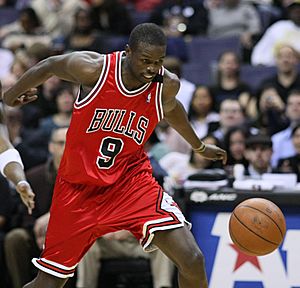
Many traditional and modern games and sports are popular in South Sudan, particularly wrestling and mock battles. The traditional sports were mainly played after the harvest seasons to celebrate the harvests and finish the farming seasons. During the matches, they smeared themselves with ochre – perhaps to enhance the grip or heighten their perception. The matches attracted large numbers of spectators who sang, played drums and danced in support of their favourite wrestlers. Though these were perceived as competition, they were primarily for entertainment.
Association football is also becoming popular in South Sudan, and there are many initiatives by the Government of South Sudan and other partners to promote the sport and improve the level of play. One of these initiatives is South Sudan Youth Sports Association (SSYSA). SSYSA is already holding football clinics in Konyokonyo and Muniki areas of Juba in which young boys are coached. In recognition of these efforts with youth football, the country recently hosted the CECAFA youth football competitions. Barely a month earlier, it had also hosted the larger East African Schools Sports tournaments.
The South Sudan national association football team joined the Confederation of African Football in February 2012 and became a full FIFA member in May 2012. The team played its first match against Tusker FC of the Kenyan Premier League on 10 July 2011 in Juba as part of independence celebrations, scoring early but losing 1–3 to the more experienced team. Famous South Sudanese footballers are James Moga, Richard Justin, Athir Thomas, Goma Genaro Awad, Khamis Leyano, Khamis Martin, William Afani Clicks and Roy Gulwak.
The South Sudanese can boast links to top basketball players. Luol Deng was a National Basketball Association star in the United States; at the international level, he represented Great Britain. Other leading international basketball players from South Sudan include Manute Bol, Kueth Duany, Deng Gai, Ater Majok, Wenyen Gabriel, and Thon Maker. The South Sudan national basketball team played its first match against the Uganda national basketball team on 10 July 2011 in Juba.
One athlete from South Sudan, Guor Marial, competed in the 2012 Summer Olympics. Due to South Sudan not as yet possessing an official Olympics organization, and Marial not yet possessing American citizenship, he, along with three athletes from the former Netherlands Antilles, competed under the banner of Independent Olympic Athletes.
On 2 August at the 128th IOC Session, South Sudan was granted full recognition of its National Olympic Committee. South Sudan competed at the 2016 Summer Olympics with three athletes in track and field. No medals were won during this Olympics.
Economy
The economy of South Sudan is one of the world's most underdeveloped with South Sudan having little existing infrastructure and the highest maternal mortality and female illiteracy rates in the world as of 2011[update]. South Sudan exports timber to the international market. The region also contains many natural resources such as petroleum, iron ore, copper, chromium ore, zinc, tungsten, mica, silver, gold, diamonds, hardwoods, limestone and hydropower. The country's economy, as in many other developing countries, is heavily dependent on agriculture.
Other than natural resources-based companies, other such organisations include Southern Sudan Beverages Limited, a subsidiary of SABMiller.
Oil
South Sudan has the third-largest oil reserves in Sub-Saharan Africa.
China National Petroleum Corporation (CNPC) is a major investor in South Sudan's oil sector. South Sudan's economy is under pressure to diversify away from oil as oil reserves will likely halve by 2020 if no new finds are made, according to the International Monetary Fund (IMF).
Images for kids
-
Rural school children participating in the USAID-funded Southern Sudan Interactive Radio Instruction project, July 2010
-
Scarified tribeswoman, South Sudan, 2011
-
Loka Teaks is the largest teak plantation in Africa.
See also
 In Spanish: Sudán del Sur para niños
In Spanish: Sudán del Sur para niños




